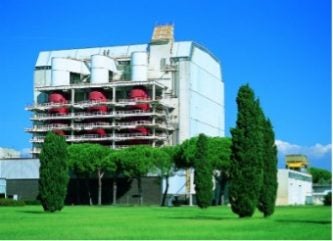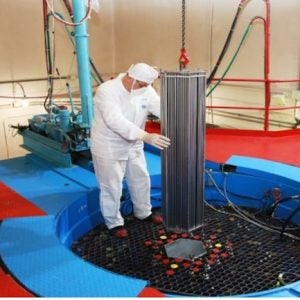
Italy’s Societa Gestione Impianti Nucleari (Sogin) has opened a dedicated area at the closed Latina NPP in preparation for dismantling its six steam generators (SGs). Sogin said this is a particularly complex activity because it involves components positioned at high altitudes. Each 3,700-tonne boiler is 24 metres high with a diameter of 6 metres. “Work is currently underway on the construction of the confinement structures that will allow the areas affected by the cutting of boilers and material handling activities to be safely isolated and maintained for the duration of the operations, with respect to the external environment,” Sogin noted.
The Latina nuclear power plant was the first to be built in Italy and belongs to the first generation of nuclear plants with a graphite gas reactor, GCR-Magnox. It was built by Eni in early 1958, and after five years, began to produce energy in May 1963, with an electric power of 210 MWe, which made it Europe’s largest NPP at that time. It was stopped in 1987 after the referendum which voted to phase out nuclear power in Italy and after it had produced a total of 26 TWh of electricity.
The fuel load and unload structures – which allowed replacing old fuel elements with fresh ones without halting the reactor activities – were dismantled in the Nineties. These operations produced about 2,400 tonnes of materials, among which 90% of cementitious materials which were sent to recovery facilities since it was non-radioactive. The remaining 10% consisted of contaminated materials that have been treated and are now stored in the temporary repositories of the plant. Sogin took over ownership of the site in November 1999.
In 2020, Italy’s Ministry of Economic Development issued a decree authorising Sogin to begin the initial phase of decommissioning – dismantling of the six SGs and the lowering of the reactor building height from 53 to 38 metres. Sogin first started demolishing the screens of the SGs. The screens are the reinforced concrete structures that insulated the pipes from the outside upper connection between the SGs and the reactor building. Each screen was made up of two parts: a horizontal upper element, connected to the reactor building, of about 145 tonnes and a lower vertical one of about 50 tonnes.
Going forward, the project involves the subsequent sectioning of each boiler into nine cylindrical parts, each weighing about 90 tonnes, progressively proceeding from top to bottom. The technique used will be cutting with diamond wire, which makes it possible at the same time to section the components inside the SGs (tie rods, spacers, shelves, sheets, etc).
The cylindrical portions will be lowered to the ground using a special crane and then transferred to the Materials Treatment Station, which has already been built, where the tube bundles will be removed, the external casing will be cut into smaller parts and decontaminated with high-pressure water. Most of the operations will be carried out using high-tech robotic systems.
The metallic materials resulting from cutting the casing will be released and sent for recycling, while the tube bundles will be treated by melting by a qualified operator, in line with Sogin’s circular economy strategy based on minimising radioactive waste.
By the end of this phase, all previous radioactive wastes generated through the operation of the plant or those produced by the dismantling of structures, systems and plant components will be stored safely at the site. These wastes will be stored both in a new interim storage facility and in some specifically adapted reactor building premises.
The whole demolition project for the reactor building will be implemented in two different stages, following two authorisation processes. The first stage, almost concluded in terms of authorisations, involves a reduction in the size of the building from 55 to 35 metres. This initial phase of decommissioning is expected to be completed in 2027 and to cost €270m ($284m). The second stage involves removing graphite, dismantling the graphite-tank and demolishing the building.
Once the planned National Repository is available, the second stage of reactor building decommissioning will be launched. Stage II will end with the release of the site free of radiological risks. This will be achieved after the dismantling of all structures and the shipment of radioactive waste to the National Repository, an operation that will also lead to the demolition of the interim storage facility. The site will then be released, without radiological restrictions, and returned to the community for its reuse.






